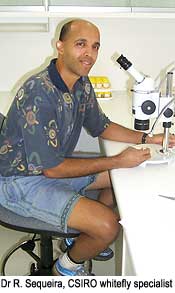Silverleaf whitefly is a growing pest threat to a wide range
of agricultural crops in eastern Australia; it’s here to stay
but it is manageable with integrated cultural, biological and
chemical control tactics.
And a surprising amount of help is coming from native
parasitic wasps – the Eretmocerus and Encarsia species in
particular – and other predatory insects that slashed whitefly
numbers in Central Queensland in the 2002-2003 season.
That was the message to private and public sector advisers at
the recent Grains Research Update in Goondiwindi from Richard
Sequeira, QDPI senior entomologist from Emerald, centre of a
coordinated whitefly control program.
Silverleaf whitefly is a major production constraint in many
parts of the world, including the United States, Israel and
other parts of the Middle East.
It has forced the virtual elimination of legumes,
particularly soybeans, from many parts of Arizona and Texas,
where it can cost cotton farmers as much as $500 million a year
in direct and indirect losses.
The pest is thought to have been entered Australia in nursery
material from the United States in the early 1990s. It spread
through horticultural areas along the Queensland and northern
New South Wales coasts before the first serious outbreak in a
broadacre crop occurred in cotton at Emerald in the 2001-02
season.
 Its damage potential is greatly enhanced by its ability to
survive on more than 500 crop and weed hosts and its propensity
to rapid resistance to insecticides. As a consequence the
Grains, Cotton and Horticulture Research and Development
Corporations to collaborate on a control program headed by CSIRO
whitefly specialist Paul De Barro and Dr Sequeira.
Its damage potential is greatly enhanced by its ability to
survive on more than 500 crop and weed hosts and its propensity
to rapid resistance to insecticides. As a consequence the
Grains, Cotton and Horticulture Research and Development
Corporations to collaborate on a control program headed by CSIRO
whitefly specialist Paul De Barro and Dr Sequeira.
The surprising news from Dr Sequeira at Goondiwindi was that
an expected explosion in whitefly numbers in the Emerald
Irrigation Area in 2002-2003 did not occur, largely due to
unexpected control from biological control agents, particularly
the native, parasitic wasps.
"Dr De Barro’s sampling of whitefly numbers in the spring of
2002 showed numbers 33 times higher than in August 2001, the
beginning
of Australia’s first major outbreak of the pest in
broadacre crops," Dr Sequeira said.
" Monitoring of silverleaf whitefly in a range of crops by
QDPI entomologists revealed 70 to 90 per cent mortality of
immature stages of the whitefly by mid January 2003 as a result
of parasitic wasp activity.
"One of the several factors that contributed to the 2001-2002
outbreak in Emerald may have been the result of widespread use
of broadspectrum organophosphate insecticides to control mirids
in cotton early in the season.
" The avoidance of OP and other broad spectrum insecticides
in cotton for most of the 2002-03 growing season is thought to
have contributed to a massive buildup of parasitic wasps, which
prevented another explosive outbreak of whitefly."
Dr Sequeira said the cross-industry approach to management of
whitefly needed to complement the role of predators and
parasitoids, with a range of actions including
crop and variety selection and time of sowing.
Farmers should not plant when other crops in the area were
finishing and never adjacent to curcurbits. There could be
multi-fold differences in tolerance and susceptibility to
whitefly between varieties of the same crop;
Using the wrong chemistry would flare silverleaf whitefly,
not control it. While the pest was resistant to pyrethroids,
organophosphates and carbomates there were newer chemicals
offering some control, although they were expensive, and proper
plant coverage was essential.
"We still have a lot of research to do, including the
development of control protocols for the cotton, grains and
horticulture industries," Dr Sequeira said. "We still need a lot
of sampling to develop thresholds for each crop and we need to
know how often we should sample and what part of the various
plants we need to sample.
"But given the current level of natural mortality, silverleaf
whitefly is unlikely to be an annual problem unless populations
are flared by local practice. I’m confident it can be managed
effectively by making well informed choices."